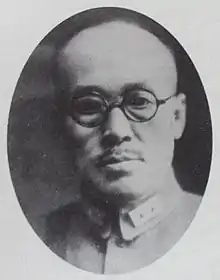Ji Cheong-cheon
Ji Cheong-cheon (Korean: 지청천; 25 January 1888 – 15 January 1957), also known as Yi Cheong-cheon, was a Korean independence activist during the period of Japanese rule (1910–1945). He later became a South Korean politician. His name was originally Ji Seok-gyu, but he took the nom de guerre Ji Cheong-cheon, meaning "Earth and Blue Sky", while leading Korean guerrilla forces against the Japanese. To hide his identity from Japanese forces while conducting military independence activities, he also used the names Ji Dae-hyoung, Ji Su-bong, and Ji Eul-gyu. His pen name was Baeksan, meaning White (Bright, Clear, Snowy) Mountain.

| Korean name | |
| Hangul | 지청천 |
|---|---|
| Hanja | 池靑天 |
| Revised Romanization | Ji Cheong-cheon |
| McCune–Reischauer | Chi Ch'ŏngch'ŏn |
| Birth name | |
| Hangul | 지석규 |
| Hanja | 池錫奎 |
| Revised Romanization | Ji Seok-gyu |
| McCune–Reischauer | Chi Sŏk Gyu |
| Also known as | |
| Hangul | 이청천 |
| Hanja | 李靑天 |
| Revised Romanization | I Cheong-cheon |
| McCune–Reischauer | Yi Ch'ŏngch'ŏn |
He was a 1914 graduate of the Imperial Japanese Army Academy; however, he defected to the Korean guerrilla forces in 1919, bringing with him knowledge of modern military techniques from his experience as a lieutenant in the Imperial Japanese Army. His skills were appreciated by the Korean guerrilla forces, who made him the superintendent of the Sinheung Military Academy, where new leaders of the Korean forces were trained.
In 1940, he became the commander-in-chief of the Korean Liberation Army, sponsored by the Chinese Nationalists. During the Second World War, he invited General Hong Sa-ik, the highest ranking Korean officer in the Imperial Japanese Army, to defect and join the Korean Liberation Army, but the invitation was declined.
Following Korea's liberation, he served as a member of the South Korea's National Assembly. He died in 1959, and was posthumously honored by the government of South Korea with the Order of Independence Merit for National Foundation in 1962.
Links
- Profile, ww2db.com; accessed 6 June 2017.